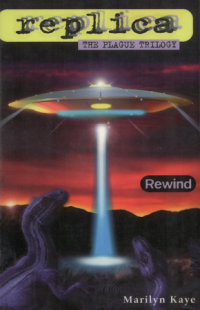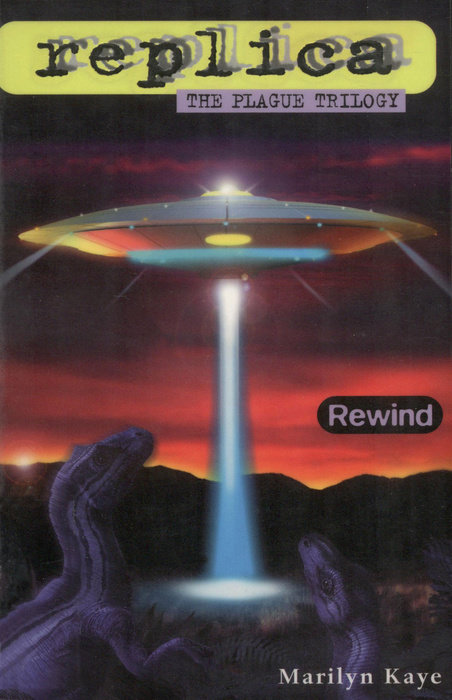one
In the Parkside Middle School media center, Amy kept her voice low as she read aloud from the encyclopedia.
“ ‘No one knows exactly why the dinosaurs disappeared completely from the face of the earth, but evidence indicates that dinosaurs died out approximately sixty-five million years ago.’ ” She looked up. “Did you get that, Linda? Sixty-five million years ago.”
Linda turned the page of her Seventeen.
“Linda?” Amy realized the girl couldn’t hear her. The flaps on her weird headgear had slipped down and were completely covering her ears. Amy leaned across the table and poked her.
Linda jumped and shrieked. This caused practically every student in the media center to do the same. The librarian, Ms. Marino, glared at them all.
Amy pointed to the flaps over Linda’s ears, and Linda lifted them.
“Don’t scare me like that!” she said.
“Sorry.” Amy couldn’t blame her for overreacting. Everyone was jumpy these days. “I was just telling you that dinosaurs disappeared sixty-five million years ago.”
“Okay,” Linda said.
“Write it down,” Amy insisted.
Linda obliged. Amy leaned over the table to watch. Muffling…
one
In the Parkside Middle School media center, Amy kept her voice low as she read aloud from the encyclopedia.
“ ‘No one knows exactly why the dinosaurs disappeared completely from the face of the earth, but evidence indicates that dinosaurs died out approximately sixty-five million years ago.’ ” She looked up. “Did you get that, Linda? Sixty-five million years ago.”
Linda turned the page of her Seventeen.
“Linda?” Amy realized the girl couldn’t hear her. The flaps on her weird headgear had slipped down and were completely covering her ears. Amy leaned across the table and poked her.
Linda jumped and shrieked. This caused practically every student in the media center to do the same. The librarian, Ms. Marino, glared at them all.
Amy pointed to the flaps over Linda’s ears, and Linda lifted them.
“Don’t scare me like that!” she said.
“Sorry.” Amy couldn’t blame her for overreacting. Everyone was jumpy these days. “I was just telling you that dinosaurs disappeared sixty-five million years ago.”
“Okay,” Linda said.
“Write it down,” Amy insisted.
Linda obliged. Amy leaned over the table to watch. Muffling a sigh of exasperation, she added three zeros to the number Linda had written. “Sixty-five million, Linda. Not thousand.”
“Yeah, whatever.” Linda returned to her magazine.
Amy leaned back in her chair and mentally harangued the social studies teacher who had assigned the partners for this project. Could Amy possibly have been given a worse partner than Linda Riviera? Was there a lazier person in the entire eighth grade at Parkside Middle School? From the second the teacher had announced the partners in class, Amy had known she would end up doing all the work.
Of course, it wasn’t going to be all that difficult for her, not with her special abilities. She could read faster, absorb information more quickly, and whip up a decent report more easily than anyone in the class. Still, it wasn’t fair that Linda would reap the rewards of Amy’s superior intelligence.
She went back to the encyclopedia article. “‘The first humanlike beings appeared on earth about three point six million years ago,’ ” she reported. But those flaps on Linda’s helmet had fallen back over her ears, and she didn’t hear. Amy risked another little poke. At least this time Linda didn’t scream.
“Could you please take that stupid thing off your head?” Amy begged.
“Are you crazy?” Linda snapped. “My father spent a fortune on this helmet. It’s the best protection money can buy. Maybe you don’t care if you drop dead, but I do.”
“I care,” Amy muttered.
“But you’re not even wearing a mask,” Linda pointed out.
Amy looked around at the other students in the media center. Some were working quietly in small groups, others were reading, a few were at the computer terminals. Almost all of them wore surgical masks covering their nose and mouth.
“My mother says those masks can’t protect anyone from the Plague,” Amy told her.
“How does she know?”
“She just happens to be a scientist. And she told me whatever this disease is, it’s not a virus. It’s not like the cold or the flu. You can’t catch it from being around someone who’s coughing or sneezing.”
Linda didn’t buy this. “I heard on the news that nobody knows what causes the Plague.”
“Yeah, that’s true. But they know it’s not contagious.”
Linda shrugged. “Well, I’m not taking any chances.”
Amy knew it wasn’t worth getting into an argument. Lots of people felt the way Linda did. Even though all the news reports told the public the disease didn’t appear to be contagious, people were wearing masks and looking suspiciously over their shoulder at the slightest sound of a cough or a sneeze. No one believed that coughs and sneezes weren’t symptoms of this particular terrible illness.
But Amy couldn’t blame people for not being logical. They were scared. The whole world was scared.
It seemed to come out of nowhere, this disease. The first few cases had popped up on a different continent, making it a distant, spooky, vague threat. Then the cases had multiplied and spread to other continents—including North America. Articles had appeared in the science sections of magazines, and now on the covers of Time and Newsweek.
The disease remained a mystery—and it was spreading more quickly. Just last week, headlines in local newspapers declared that three cases had been diagnosed right here in Los Angeles. One of the victims had already died. Another was in what they called a permanent vegetative state, which didn’t sound very pleasant. The third had recovered—sort of. But he was now in a wheelchair. Doctors had given the disease a long, unpronounceable scientific name, but everyone else just called it the Plague. With a capital P.
The symptoms varied: Some people started feeling tired, others became anxious. Some had headaches, some had backaches. In some victims, the disease progressed slowly. Others fell apart overnight. Ultimately, they all collapsed and went into a coma. Some peo- ple came out of the comas but suffered severe brain damage. Blindness, deafness, and paralysis were common. Some people lost their memory. Others went completely insane. The majority didn’t survive.
All kinds of medical researchers were examining the stricken patients, running tests, studying blood sam- ples under microscopes. They could see that something was clearly wrong. Actually, that wasn’t exactly it. They could see that something was wrong—but there was nothing clear about it. Where had the Plague come from? How had people caught it? No one could figure it out. And tension, anxiety, and depression hovered over the earth like a fog. At Parkside Middle School, as everywhere else in the world, the fear was present. But teachers and parents were determined to try to keep life as normal as possible for the students. So the kids went to classes, ate their lunches, did their homework assignments, and challenged the occasional school regulation. In fact, at that very moment in the school media center, a major rule was being broken. Someone had left a cell phone on, and it was ringing.
Ms. Marino’s head jerked up sharply again. Half the students in the media center frantically rummaged through their backpacks and handbags. Amy checked her own cell phone to make sure it was turned off. Not that she used it much. Her best friend, Tasha, didn’t have a cell phone, and Amy’s mother knew better than to call her at school.
The earflaps didn’t prevent Linda from hearing and identifying the ring. She dove into her bag and pulled out a phone.

